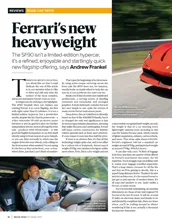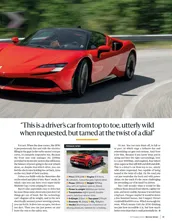Visually the car is very neat, without obvious aerodynamic addenda, as the majority of its downforce is generated under the car and by a deployable rear spoiler. There are, quite deliberately, elements of 250LM about its rear wings too. The inside is similarly clean and, most importantly, uses the superb full-width high definition information screen first seen in the SF90. Ferrari owners who had cursed the clunky, unintuitive and messy infotainment systems used by its other models will be simply amazed at how beautiful and easy to use the new system is.
The 296GTB doesn’t go on sale even in Europe until the first quarter of next year and right-hand drive production always follows behind, so it’s likely we’ll not be seeing them on British roads until next spring at the earliest. When they do, the base price will be around £230,000, though of course none will actually be sold for that or, indeed, anything less than a quarter of a million minimum. Ferrari is not shy about encouraging its punters to get busy with the options list and, to be fair, very few of them need much persuading.
But even at £230k, this positions it clearly ahead of the F8 Tributo at £203,000, but also a veritable a bargain relative to the £375,000 SF90. When I drove the SF90, however impressed I was by its power and poise, I did wonder (and write) about how much better it would have been if it had been made lighter, cheaper and more practical by the deletion of its driven front axle. And the 296GTB is the car that does precisely that. Given the SF90 has barely a boot to speak of and its power to weight ratio of 628bhp per tonne is not so far from the GTB’s 556bhp per tonne, and given the fact that neither car will have a performance level you can actually exploit on a public road, the SF90 is a car in danger of being rendered an irrelevance by its new, cheaper, better looking little sister.








